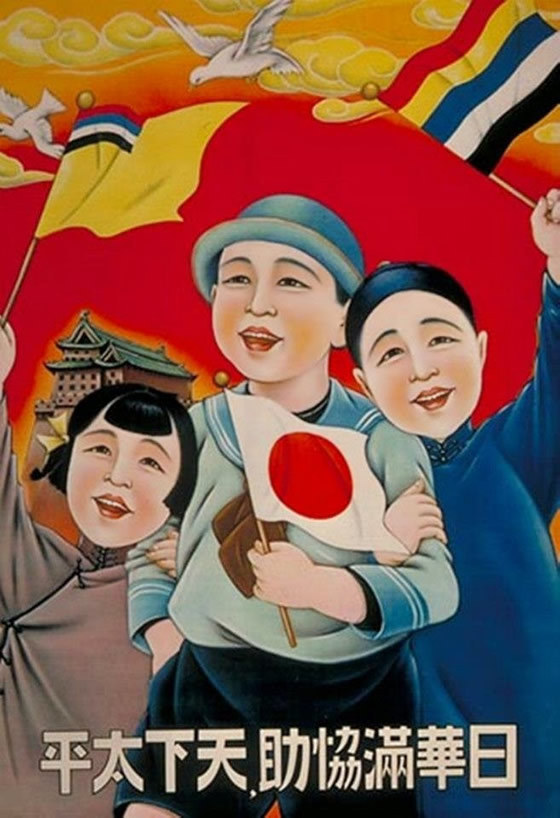 |
| Greater East Asia Co-Prosperity Sphere |
The formal concept of the Greater East Asia Co-Prosperity Sphere was announced at a press conference on August 1, 1940, by Japanese prime minister Matsuoka Yosuke. It was to be an autarkic bloc of Japanese-led Asian nations free from Western influence or control. Greater East Asia included both East Asia and Southeast Asia.
Japan's imperialist leaders regarded its values and ideals as superior to those of the rest of the world, including its East Asian neighbors. They took upon themselves the right to replace what they regarded as the conservative and negative influences of China and India within its borders. Japan would "civilize" the rest of Asia. The method chosen to spread the "benefits" of Japanese civilization was the Greater East Asia Co-Prosperity Sphere.
The Meiji Restoration of 1868 brought Japan back into diplomatic contact with the West. Exposure brought awareness that the West far surpassed Japan technologically. Japanese leaders realized that to avoid the humiliation of being treated as a second-class country Japan would have to modernize on the Western model.
  |
To develop a "rich economy and strong army," Japan began modernizing its political, economic, and military systems. As early as the 1880s Japanese intellectual leaders such as Fukuzawa Yukichi encouraged the idea that Japan had a manifest destiny to be Asia's leader. Imperialist groups such as the Black Dragon Society and Kita Ikki became popular forums for those who wanted to expel the foreigners.
Japanese Imperialism
Japan believed it had earned its right to be as imperialistic as Western nations. As a result, Japan began subjecting its neighbors to its rule. It expanded into Hokkaido, subdued the indigenous Ainu, established treaty ports with extraterritoriality in Korea, took the Ryukyus, and fought a successful war with China.
Expansion was to gain prestige, materiel, and markets, similar to the goals of imperialism of the Western nations. Indicating how successfully it had mastered the Western ways of imperialism and modernism, Japan beat Russia soundly in the Russo-Japanese War in 1905.
But the Western nations still looked down on Japan, which it resented. At the Paris Peace Conference in 1919, the Western powers rejected a Japanese demand for insertion of a racial equality clause in the League of Nations covenant.
As a result, Japan felt the need to prove that it was as superior. By 1932 Japan had subjected Taiwan, Korea, and Manchuria to its control. The local populations of the conquered lands were exploited for the benefit of Japan.
After nearly half a century of conquest and exploitation, Japan enunciated the concept of the Greater East-Asia Co-Prosperity Sphere as justification for its aggression. Anticipating a long struggle to develop the new Asia under Japan, its war planners established a multistage process to acquire resources of the region as follows: Raw materials and surplus food would come from the southern region, while Manchuria and North China would provide the resources for heavy industry. The remaining areas of the sphere and parts of Asia outside it would serve as Japan's market. Japan would oversee the whole by providing planning, tools, skills, and military control.
Geographic Boundaries
The geographic boundaries of the sphere were fluid, varying over time and political circumstance. They encompassed the Micronesian mandates and often Melanesia and Polynesia and consistently included Hawaii. It had three concentric rings.
The innermost one included Japan, Korea, and Manchuria. A second ring would include China and extend to Hawaii. A third ring would include whatever area was necessary to guarantee the total economic self-sufficiency of greater East Asia.
Areas of the sphere were divided into four categories. Some lands were to be annexed outright; they included Guam, Mindanao, and Hawaii. Others, including Indochina and the Dutch East Indies, were to become protectorates.
Some would be independent but would have unbreakable economic and defense bonds with Japan; these would be Hong Kong, Thailand, and the Philippines. The fourth group was independent states with economic ties to Japan; they would include Australia, New Zealand, and India.
Japan had economic rationale for enlarging the sphere. It felt heavy pressure to find sources to become economically self-sufficient due to a Western embargo on key resources. It needed the oil of the Dutch East Indies and the rubber of Indochina to support its industries and its military venture in China. It also justified its imperialism by a perceived need for guaranteed markets for its manufactured goods as well as space for colonization by its people.
The Japanese had to sell their exploitative venture to the exploited. Their slogan was "Asia for Asians," and their message was the imperative of freeing Asia from the Western yoke. They promised economic equity and growth. To provide cover for their conquest, they installed puppets, local people who had the power to declare independence from the Western powers but not the power to exercise independence from Japan.
On December 12, 1941, Japanese media announced that the just-begun war it had instigated by attacking the United States, Britain, and the Netherlands in Asia was the "Greater East Asia War," a crusade to rid greater East Asia of Chiang Kai-shek, communism, and Westerners.
Defeat by the United States and the Allies in 1945 ended Japan's imperial dream and the Greater East Asia Co-Prosperity Sphere.